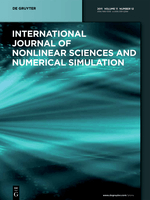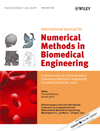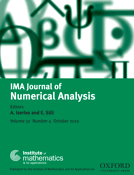
International Journal of Computational Methods
Scope & Guideline
Unveiling cutting-edge techniques to transform computational challenges.
Introduction
Aims and Scopes
- Computational Mechanics:
The journal publishes research on computational mechanics, focusing on numerical methods for analyzing mechanical systems, material behavior, and structural integrity. - Numerical Simulation Techniques:
A core area of the journal includes the development and application of various numerical simulation techniques such as finite element analysis, boundary element methods, and meshless methods for solving complex engineering problems. - Interdisciplinary Applications:
Research that bridges multiple disciplines such as fluid dynamics, solid mechanics, and thermal analysis is emphasized, showcasing the versatility of computational methods in real-world applications. - Algorithm Development:
The journal highlights innovative algorithms designed to improve computational efficiency and accuracy, particularly in high-dimensional and stochastic problems. - Reliability and Uncertainty Analysis:
A significant focus is placed on methods for assessing the reliability of structures and systems under uncertainty, addressing probabilistic and non-probabilistic approaches.
Trending and Emerging
- Machine Learning and AI Integration:
There is a growing trend in integrating machine learning and artificial intelligence into computational methods, enhancing predictive capabilities and optimizing design processes. - Advanced Material Modeling:
Emerging themes in the modeling of complex materials, such as functionally graded materials and composites, are increasingly prevalent, reflecting the demand for sophisticated approaches in material science. - Real-Time and Adaptive Simulation Techniques:
Research focusing on real-time simulation and adaptive methods is on the rise, driven by the need for dynamic analysis in engineering applications such as robotics and structural monitoring. - Hybrid Numerical Methods:
The development of hybrid methods that combine various numerical techniques is gaining interest, facilitating more robust and versatile solutions to complex problems. - Sustainability and Environmental Applications:
An emerging focus on sustainability and environmental challenges is evident, with computational methods being applied to optimize resource use and assess environmental impacts.
Declining or Waning
- Basic Theoretical Approaches:
While foundational theories are essential, there is a noticeable decline in publications focusing solely on theoretical approaches without practical applications, as the journal shifts towards more applied computational methods. - Traditional Finite Element Methods:
Standard finite element methods are being overshadowed by more advanced and hybrid techniques, like meshless and adaptive methods, reflecting a waning interest in traditional approaches. - Single-Disciplinary Focus:
Research that is strictly confined to a single discipline is becoming less common, as interdisciplinary approaches gain traction. This indicates a shift towards integrating methods across various fields.
Similar Journals

Advances in Applied Mathematics and Mechanics
Unveiling Insights in Mathematics and Mechanical EngineeringAdvances in Applied Mathematics and Mechanics is a premier academic journal published by GLOBAL SCIENCE PRESS that focuses on the latest research and innovative developments in the fields of applied mathematics and mechanical engineering. Since its inception in 2009, this journal has consistently contributed to the advancement of knowledge, garnering a respectable Q2 ranking in both Applied Mathematics and Mechanical Engineering categories, reflecting its significance in enhancing scientific discourse. With an impactful reach, as evidenced by its Scopus rankings, this journal hosts cutting-edge research, theoretical advancements, and practical applications that serve as invaluable resources for researchers, professionals, and students alike. While it operates under a subscription model, the accessibility of vital research findings is critical for driving innovation within these interrelated disciplines. The journal’s scope encompasses a broad range of topics, from computational methods to engineering applications, positioning it as a crucial platform for interdisciplinary collaboration and knowledge sharing in an ever-evolving academic landscape. For prospective authors and readers, Advances in Applied Mathematics and Mechanics stands as a key contributor to confidently navigating the nexus of applied mathematics and mechanics.

Izvestiya of Saratov University Mathematics Mechanics Informatics
Bridging Disciplines: Mathematics, Mechanics, and InformaticsIzvestiya of Saratov University Mathematics Mechanics Informatics is a prominent open access journal published by Saratov State University, focusing on the interdisciplinary fields of mathematics, mechanics, and computer science. Established as an accessible platform for researchers since 2007, this journal fosters the dissemination of innovative research and advancements in computational mechanics, general mathematics, and mechanical engineering among others. Although currently categorized within the Q4 quartile rankings in various domains, including Computational Mechanics and Mechanics of Materials, it serves as a crucial resource for professionals and scholars aiming to explore emerging trends and methodologies. Operating out of Saratov, Russian Federation, this journal not only contributes to local academic discourse but also holds international relevance, welcoming submissions that push the boundaries of traditional research. Researchers, professionals, and students alike are encouraged to engage with the wealth of knowledge presented within its pages, reinforcing the journal’s role as a vital component in the ongoing development of these scientific fields.

COMPUTERS & FLUIDS
Exploring Innovative Solutions in Computer Science and EngineeringCOMPUTERS & FLUIDS, published by PERGAMON-ELSEVIER SCIENCE LTD, is a premier journal in the fields of Computer Science and Engineering, with a distinguished history dating back to 1973. Its Q1 ranking in both Computer Science (Miscellaneous) and Engineering (Miscellaneous) illustrates its high impact and relevance, being positioned among the top tier of scientific publications. With a robust focus on the intersection of computational methods and fluid dynamics, this journal serves as a vital platform for researchers, professionals, and students dedicated to advancing knowledge and technology within these domains. Although it is not an open-access journal, its articles are accessible through various academic institutions and libraries, ensuring that vital research reaches its intended audience. Readers can explore innovative methodologies and applications, reinforcing the journal's commitment to enhancing the understanding of fluid mechanics through cutting-edge computational approaches. For more details, visit the official website of COMPUTERS & FLUIDS to stay abreast of the latest research advancements.

INTERNATIONAL JOURNAL OF NONLINEAR SCIENCES AND NUMERICAL SIMULATION
Pioneering Research in Nonlinear PhenomenaINTERNATIONAL JOURNAL OF NONLINEAR SCIENCES AND NUMERICAL SIMULATION, published by WALTER DE GRUYTER GMBH, serves as a premier platform for advancing knowledge in the vibrant domains of applied mathematics, computational mechanics, and various fields of engineering and physics. With an ISSN of 1565-1339, this journal has been at the forefront of disseminating significant research findings since its inception in 2000. Its commitment to quality is reflected in its category quartiles for 2023, ranked Q2 in Computational Mechanics and Engineering (miscellaneous), and Q3 in multiple engineering disciplines. Although it currently operates under a subscription model, the journal remains dedicated to presenting groundbreaking studies that explore complex nonlinear phenomena and numerical methodologies. As an invaluable resource for researchers, professionals, and students alike, the journal aims to foster innovation and collaboration across related fields, enhancing both theory and application through its peer-reviewed articles.

ESAIM-Mathematical Modelling and Numerical Analysis
Pioneering Insights in Modeling and AnalysisESAIM-Mathematical Modelling and Numerical Analysis, published by EDP SCIENCES S A, is a prestigious open-access journal at the forefront of the fields of mathematical analysis, applied mathematics, computational mathematics, modeling, simulation, and numerical analysis. With an impressive Q1 ranking in multiple categories for 2023, the journal is recognized for its contribution to advanced research, particularly in areas that intertwine mathematical theory with practical applications. The journal’s ISSN is 2822-7840 and its E-ISSN is 2804-7214, showcasing its commitment to both traditional and digital dissemination of knowledge. Spanning from 1996 to 2024, ESAIM has established itself as a vital platform for scholars seeking to publish innovative research and engage with the latest advancements in the field. Researchers and practitioners can explore the journal’s content through various access options, fostering a collaborative environment for the sharing and development of new mathematical methodologies. Situated in France, ESAIM continues to attract an international readership, driving forward the global discourse in mathematical sciences.

Journal of Computational Applied Mechanics
Fostering Innovation in Applied Mechanics ResearchJournal of Computational Applied Mechanics, published by UNIV TEHRAN, DANISHGAH-I TIHRAN, is an influential open-access journal that has been disseminating significant research findings since its inception in 2012. With a dedicated focus on the fields of Computational Mechanics, Mechanical Engineering, and Mechanics of Materials, this journal has garnered a Q3 ranking in multiple relevant categories as of 2023, indicating its burgeoning impact within the academic community. Although precise HIndex scores are currently unavailable, the journal's recognition is underscored by its Scopus rankings, placing it in the middle tier among its peers. The journal invites researchers, professionals, and students to contribute to and engage with the continually evolving discourse in applied mechanics, fostering innovation through the dissemination of quality research. As an open-access journal, it ensures that findings are readily accessible to a global audience, thereby enhancing collaboration and knowledge sharing in the scientific community.

Mechanics of Solids
Bridging Theory and Application in Solid MechanicsMechanics of Solids, published by PLEIADES PUBLISHING INC, is a vital academic journal dedicated to the study of mechanics within solid materials, encompassing fundamental principles and cutting-edge research. With an ISSN of 0025-6544 and an E-ISSN of 1934-7936, this journal bridges the gap between theoretical and applied mechanics, offering insights valuable to both researchers and practitioners in the field. Historically spanning from 1975 to 1989 and continuing from 2008 to 2024, it serves as a comprehensive resource for developments in mechanics of materials and interdisciplinary physics. Despite its current positioning in Q4 in Mechanics of Materials and Q3 in Physics and Astronomy for 2023, the journal is striving to enhance its impact and visibility, as reflected in its rankings in Scopus, which places it in the 24th percentile for General Physics and Astronomy and 19th percentile for Mechanics of Materials. While the journal currently does not offer Open Access, it remains committed to providing quality, peer-reviewed content that fosters innovation and knowledge dissemination for its diverse readership in the United States and beyond. The journal's continued relevance in the evolving landscape of engineering physics and materials science positions it as a crucial platform for scholarly exchange and advancement.

International Journal for Numerical Methods in Biomedical Engineering
Pioneering Research at the Forefront of Biomedical EngineeringInternational Journal for Numerical Methods in Biomedical Engineering is a premier peer-reviewed journal dedicated to promoting advancements in numerical methods and their applications in the biomedical engineering field. Published by WILEY and based in the United States, this journal serves as a vital platform for disseminating innovative research from 2010 to 2024, with a focus on bridging the gap between computational techniques and real-world biomedical challenges. With an impressive impact factor and categorized in the Q2 quartile across several fields including Applied Mathematics and Biomedical Engineering, it ranks among the top journals in its domain. The journal provides free access to its content, making it an invaluable resource for researchers, professionals, and students eager to explore groundbreaking methodologies. By fostering interdisciplinary collaboration and showcasing high-quality research, International Journal for Numerical Methods in Biomedical Engineering plays a crucial role in advancing our understanding of complex biomedical systems through numerical analysis.

International Journal of Numerical Analysis and Modeling
Empowering Knowledge Exchange through Open AccessThe International Journal of Numerical Analysis and Modeling, published by ISCI-INST SCIENTIFIC COMPUTING & INFORMATION, is a leading platform for research in the field of numerical analysis. With an ISSN of 1705-5105 and an E-ISSN of 1705-5105, this esteemed journal has been disseminating rigorous and innovative studies since its inception in 2004. Covering a diverse range of topics within numerical analysis, it has successfully positioned itself in Q2 of the 2023 category quartiles and ranks 46th out of 88 in its Scopus classification, showcasing its relevance and impact within the academic community. Operating under an open access model, it ensures that research findings are accessible to a global audience, fostering collaboration and knowledge exchange. Based in Canada, this journal not only highlights advancements in computational methodologies but also addresses real-world applications, bridging theoretical frameworks with practical solutions. Researchers, professionals, and students alike will find valuable insights and up-to-date contributions in this crucial field of study.

IMA JOURNAL OF NUMERICAL ANALYSIS
Unveiling the Future of Computational ResearchIMA Journal of Numerical Analysis, published by Oxford University Press, stands as a premier platform for cutting-edge research in the field of numerical analysis, exemplifying the latest advancements and methodologies in applied, computational, and general mathematics. Since its inception in 1981, this esteemed journal has continually contributed to the academic community by publishing high-quality, peer-reviewed articles that foster innovation and collaboration among researchers. With an impressive Q1 ranking across multiple categories, including Applied Mathematics and Computational Mathematics, it plays a crucial role in disseminating knowledge, as indicated by its Scopus rankings which place it in the top 25% of journals within its field. Although the journal is not open access, it remains a vital resource for academics, professionals, and students eager to engage with the ongoing evolution of numerical methods. By serving as a conduit for novel ideas and rigorous research, the IMA Journal of Numerical Analysis ensures that its contributors and readers are at the forefront of this dynamic discipline.